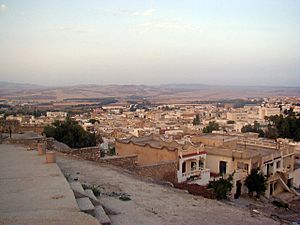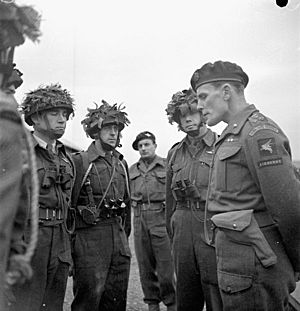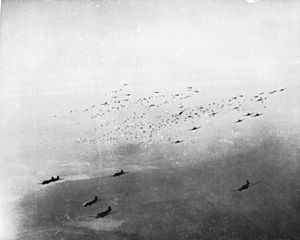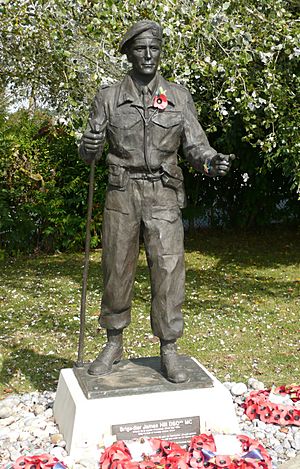James Hill (British Army officer) facts for kids
Quick facts for kids
James Hill
|
|
|---|---|
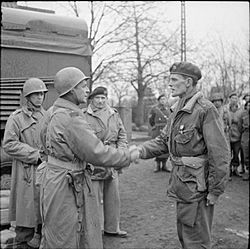
Major General Matthew Ridgway (left), commanding U.S. XVIII Airborne Corps, decorates Brigadier James Hill with the American Silver Star, March 1945. Pictured also in the middle is Field Marshal Sir Bernard Montgomery.
|
|
| Nickname(s) | "Speedy" |
| Born | 14 March 1911 Bath, Somerset, England |
| Died | 16 March 2006 (aged 95) Church Farm Care Home, Cotgrave, Nottingham, England |
| Allegiance | United Kingdom |
| Service/ |
British Army |
| Years of service | 1931–1948 |
| Rank | Brigadier |
| Service number | 52648 |
| Unit | Royal Fusiliers Parachute Regiment |
| Commands held | 1st Parachute Battalion 9th Parachute Battalion 3rd Parachute Brigade 1st Parachute Brigade 4th Parachute Brigade |
| Battles/wars | Second World War |
| Awards | Distinguished Service Order & Two Bars Military Cross Silver Star (United States) King Haakon VII Liberty Cross (Norway) Legion of Honour (France) |
James Hill (1911–2006) was a brave British Army officer. He was a Brigadier and led the 3rd Parachute Brigade. This unit was part of the 6th Airborne Division. He fought in many important battles during the Second World War.
Born in Bath, Somerset, England, Hill joined the army in 1931. He first served with the Royal Fusiliers. Later, he became a paratrooper and joined the Parachute Regiment. He was known for his courage and leadership. He received many awards for his service. These included the Distinguished Service Order (DSO) three times and the American Silver Star.
Contents
Early Life and Army Start
James Hill was born on March 14, 1911, in Bath, Somerset. His father was also a Major General in the army. James went to Marlborough College. He then attended the Royal Military Academy Sandhurst. There, he won the "Sword of Honour" for being the best cadet. He also became captain of athletics.
In 1931, he joined the British Army. He became a 2nd lieutenant in the Royal Fusiliers. This was the same regiment his father commanded. He was very active in sports, running the regimental athletic and boxing groups. In 1936, he left active service for a short time. He worked for his family's ferry company.
Second World War Service
When the Second World War started in September 1939, Hill rejoined his regiment. He went to France with the 2nd Battalion, Royal Fusiliers. His unit was part of the 4th Infantry Division. He commanded a small group of soldiers (a platoon) for several months. They were stationed along the Maginot Line.
In January 1940, he was promoted to Captain. He joined the staff at Allied Headquarters. During the Battle of France in May 1940, he worked with Field Marshal Lord Gort. He helped plan the evacuation of civilians from Brussels. He also delivered important orders for British troops to withdraw. At the end of the campaign, he managed the evacuation of soldiers from the beach at La Panne. He was on the last destroyer to leave Dunkirk. For these actions, he received the Military Cross.
After returning to Britain, he was promoted to Major. He then volunteered for the new Parachute Regiment. He completed parachute training. When the 1st Parachute Battalion was formed in August 1941, he became its second-in-command.
Fighting in North Africa
The 1st Parachute Battalion was part of the 1st Parachute Brigade. In November 1942, this brigade went to North Africa for Operation Torch. This was the Allied invasion of North Africa. Hill's battalion was chosen for a parachute drop near Souk el-Arba and Béja in Tunisia.
The mission had many challenges. The American pilots had never done a parachute drop before. There were no good maps or photos of the area. Hill himself sat in the cockpit of the lead plane to help the pilot. On November 16, 1942, the battalion successfully dropped near Souk el-Arba. Most paratroopers landed safely.
Hill then led about 525 soldiers in trucks to Béja. This was an important road and railway center. He convinced the local French troops to work with them. To make his force seem larger, he had his battalion march through the town multiple times. They changed their hats and equipment each time.
His troops set up ambushes for German convoys. In one ambush, they destroyed several armored cars and captured German soldiers. Hill also helped defend a vital bridge at Medjez el Bab. Despite fierce fighting, the Allied forces eventually lost the bridge to stronger German forces.
Later, Hill decided to attack an Italian force with tanks at Gue Hill. He led the attack himself. He bravely approached three Italian tanks with only his revolver. He managed to get two tank crews to surrender. But the third tank fired, hitting Hill three times in the chest. He was badly wounded but survived. For his bravery in North Africa, he received the Distinguished Service Order (DSO) and the French Legion of Honour.
Normandy Landings
After recovering from his injuries, Hill returned to England in February 1943. He took command of the new 3rd Parachute Brigade. He was known for his tough training methods. He made his unit work six and a half days a week to get them fit. In April 1943, his brigade joined the new 6th Airborne Division.
The 6th Airborne Division was chosen for Operation Tonga. This was the British airborne landing in Normandy on the night of June 5/6, 1944, known as D-Day. Their job was to protect the left side of the main invasion beaches. They had to capture bridges and stop German attacks.
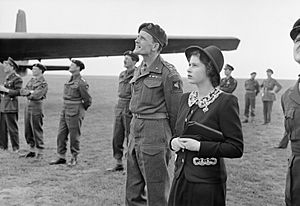
The drop was difficult due to bad weather and scattered landings. Hill himself landed in a flooded area. He had to wade through deep water to reach dry land. Later, he was strafed by German aircraft. He was wounded in the buttocks, and many of his men were killed or wounded.
Despite his injury, Hill continued to lead. His brigade successfully completed its main tasks. For the next few months, the 6th Airborne Division fought as infantry. They held their ground against strong German attacks. On June 12, German forces heavily attacked the 9th Parachute Battalion. Hill quickly gathered 40 paratroopers and led a counter-attack. This forced the Germans to retreat. For his leadership during this period, he received a Bar to his DSO. This meant he had earned the DSO for a second time.
The division then advanced towards the River Seine. Hill's 3rd Parachute Brigade led the way. They fought through tough German resistance. By late August, the division had advanced 45 miles. They captured over 1,000 German soldiers. They were then pulled back to England in September 1944.
Battle of the Bulge
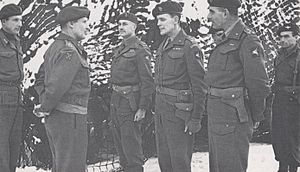
In December 1944, Germany launched a surprise attack in the Ardennes forest. This was known as the Battle of the Bulge. The 6th Airborne Division was quickly sent to Belgium. They arrived on Christmas Eve. Hill was in the hospital for surgery when the attack began. But he quickly rejoined his brigade.
His brigade was positioned near Rochefort. They did not see much direct fighting. The German units facing them withdrew without a fight. By the end of January, the division moved to the Netherlands. They patrolled along the Maas river. In late February, they returned to England to prepare for a new operation.
Crossing the Rhine
On March 24, 1945, Operation Varsity began. This was a huge airborne operation to help cross the River Rhine. The British 6th Airborne Division and the U.S. 17th Airborne Division were involved. Their mission was to secure areas east of the Rhine. They needed to capture a forest, bridges, and the town of Hamminkeln.
Hill's 3rd Parachute Brigade landed accurately. But they faced German soldiers hidden in the Diersfordterwald forest. Hill's own headquarters was still occupied by Germans. He ordered an officer to clear it, who was killed in the process. Hill himself was almost hit by a glider carrying his own Jeep. Despite heavy casualties, his brigade secured all its objectives by early afternoon.
After this success, the 6th Airborne Division advanced eastward. Hill rode alongside his brigade on a motorcycle. They moved very quickly through Germany. At one point, Hill's batman (personal assistant) took a German colonel's binoculars. Hill disapproved of looting but joked that if his batman got him a pair too, he could keep them.
The brigade continued its fast advance. They covered 103 miles in 14 days. They captured over 19,000 German prisoners. By April 23, they reached the River Elbe. Their final goal was to reach the port of Wismar before the Russian Army. Hill's troops were the first to enter Wismar. They beat a Russian tank column by just a few miles.
On May 7, 1945, Germany surrendered. The war in Europe ended. Hill received a second Bar to his DSO. This meant he had earned the DSO for a third time. He also received the American Silver Star for his leadership.
After the War
In May 1945, James Hill served as the military governor of Copenhagen, Denmark. For this, he received the King Haakon VII Liberty Cross. He then commanded the 1st Parachute Brigade. He helped with the process of sending soldiers home.
He retired from the British Army in July 1945. However, he continued to serve in the Territorial Army. In 1947, he formed and commanded the 4th Parachute Brigade (Territorial Army). He led this unit until 1949.
After leaving the army, Hill worked for several companies. He was on the board of Lloyds Bank. He also loved birdwatching. He was only the second person to find a cuckoo's egg in a whinchat nest.
He helped set up the Parachute Regiment Association. He also supported the Airborne Forces Security fund. He was a trustee for 30 years and chairman for five years. James Hill married Joan Patricia Haywood in 1986.
On June 6, 2004, he attended the 60th Anniversary of the Normandy landings. A bronze statue of him was unveiled in France. Charles, Prince of Wales, who is the Colonel-in-Chief of The Parachute Regiment, was there. James Hill passed away on March 16, 2006, at the age of 95.


